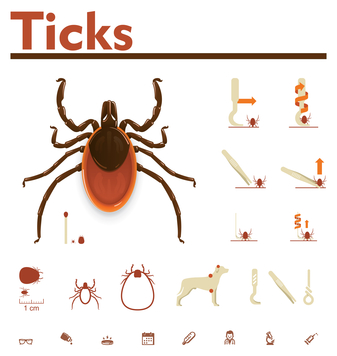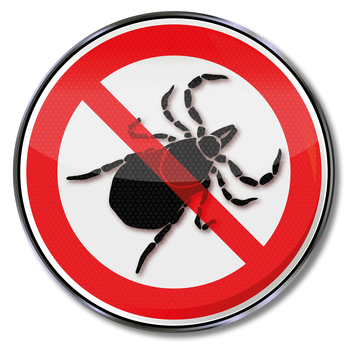Why Increasing Tick Awareness In Highland, MD Is A Good Idea
In a world where good health seems to be elusive, it is important to keep yourself out of harm’s way. Unfortunately, there are lots of pathogens all over Howard County. In fact, if you were told just how many health risks surround you, it will sound unbelievable. Thank goodness for an amazing immune system that can combat countless pathogens naturally.

Even so, being on the lookout where ticks are concerned is vital. These little bugs can cause a lot more damage than you might give them credit for. Surprisingly, the greatly dreaded black-legged deer tick is not the only type of tick out there.
Lone star tick
Have you heard of ticks that cause an allergic reaction to red meat (a.k.a. alpha-gal allergy)? This is the one! Be warned: The CDC says this is “a very aggressive tick that bites humans” and transmits bacteria that cause a wide range of diseases.
Look for: You can identify a female lone star tick pretty easily, thanks to the white dot (the lone star) on its back.
Disease risk: ehrlichiosis, tularmemia, Heartland virus disease, Bourbon virus disease, Southern tick-associated rash illness
Location: You can find this critter in the eastern U.S., but more commonly in the southeastern states. It’s found as north as Iowa and Illinois in the midwest to parts of Maine down into the Gulf Coast states. Read more at Prevention.com…
There are six other types of ticks you need to beware of. Thankfully, with such information, you can be ready at all times. If you suspect that you have seen one, you will do well to report it.

Ever wondered why ticks are so dangerous? Or how they become so lethal to you and your family? Or in what ways they spread disease? Here’s how they do it:
Ticks transmit pathogens that cause disease through the process of feeding.
-
Depending on the tick species and its stage of life, preparing to feed can take from 10 minutes to 2 hours. When the tick finds a feeding spot, it grasps the skin and cuts into the surface.
-
The tick then inserts its feeding tube. Many species also secrete a cement-like substance that keeps them firmly attached during the meal. The feeding tube can have barbs which help keep the tick in place.
-
Ticks also can secrete small amounts of saliva with anesthetic properties so that the animal or person can’t feel that the tick has attached itself. If the tick is in a sheltered spot, it can go unnoticed.
-
A tick will suck the blood slowly for several days. If the host animal has a bloodborne infection, the tick will ingest the pathogens with the blood.
-
Small amounts of saliva from the tick may also enter the skin of the host animal during the feeding process. If the tick contains a pathogen, the organism may be transmitted to the host animal in this way.
-
After feeding, most ticks will drop off and prepare for the next life stage. At its next feeding, it can then transmit an acquired disease to the new host. Read more at CDC…
Sounds pretty disgusting, right? Just like mosquitoes, ticks cause disease when they bite you. So, if you notice one on your skin and properly remove it immediately, you may be lucky.

Your swift action could keep you from contracting the dreaded Lyme disease. Additionally, there are several other diseases ticks can transmit and which you can avoid. The following post describes them in detail:
Other tick-borne illnesses include the Powassan virus, an illness that can cause serious complications including seizures, coma and even death in rare cases; and Tularemia, another serious illness caused by the Francisella tularensis bacteria. Tularemia can lead to skin ulcers, swollen lymph glands and flu-like symptoms.
The list of tick-borne illness is a long one. There are 16 known around the world that can affect humans. They include the Colorado tick fever, which causes flu-like symptoms and a biphasic fever (a fever that goes away and comes back again); anaplasmosis and ehrlichiosis, which can lead to respiratory failure and death in rare cases; and babesiosis, which is caused by a parasite that attacks red blood cells.
Most of the tick-borne illnesses mentioned above can be found in the United States, particularly the Midwest or in western Canada. Lyme disease, however, can be found all over the world. Read more at BCA Lab…
Clearly, ticks are not the kind of bugs you want to tolerate. They can cause serious harm and disease to you and your pets. Being extra vigilant in identifying, treating promptly, and if possible, preventing a tick encounter, is important.
At Backyard Bug Patrol, we are passionate about tick control because we know how dangerous they are. You can trust us to do a thorough job. Through our tick control package, we will eliminate any signs of ticks around your home. Call us today for the best services in town.
Related posts:
- A Tick-Related Disease Glenelg, MD Residents Should Be Wary Of
- Lyme Disease May Be Mistaken For Covid-19: What Elkridge, MD Residents Should Know
- Rodent Problems In 2020 And How To Protect Your Woodbine, MD Home
- Impressive Ant Facts Columbia MD Residents May Find Interesting
- Excited About Going Outdoors In Ellicott City, MD? Ticks Are Excited Too!
